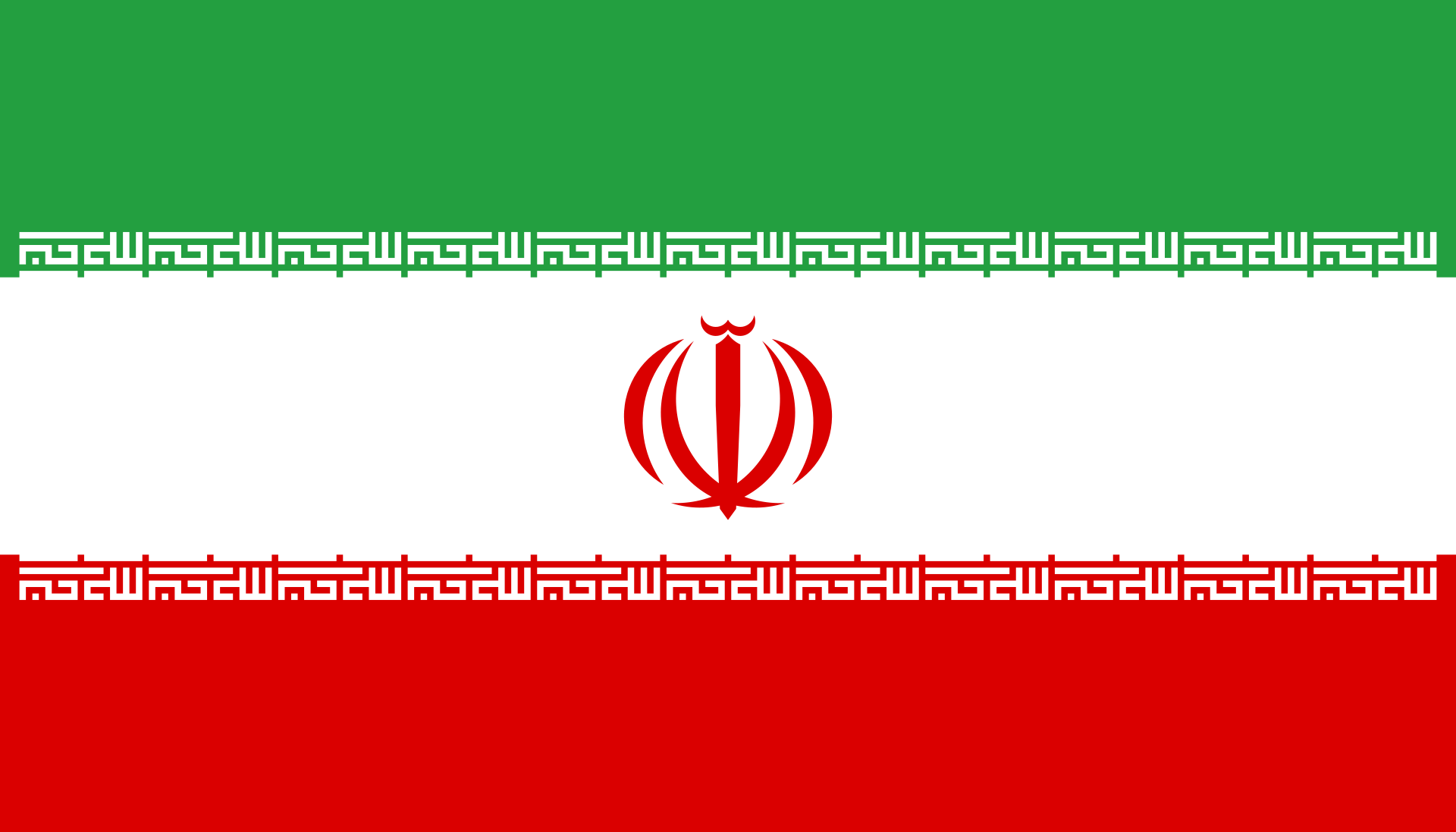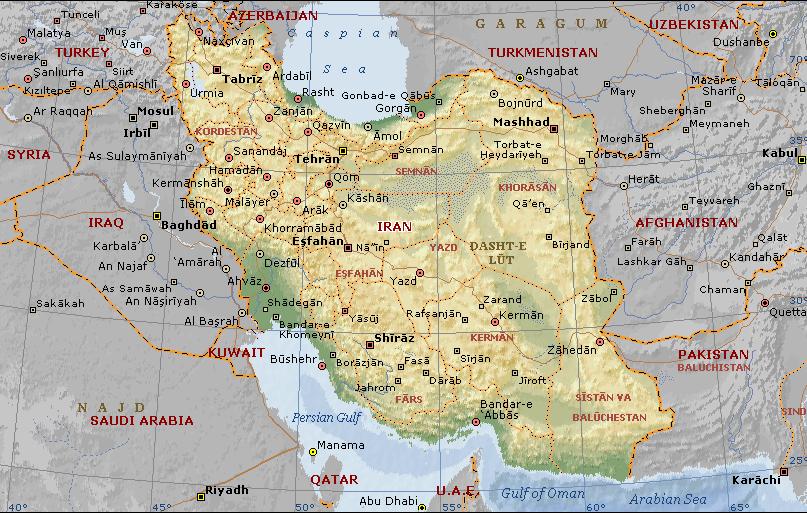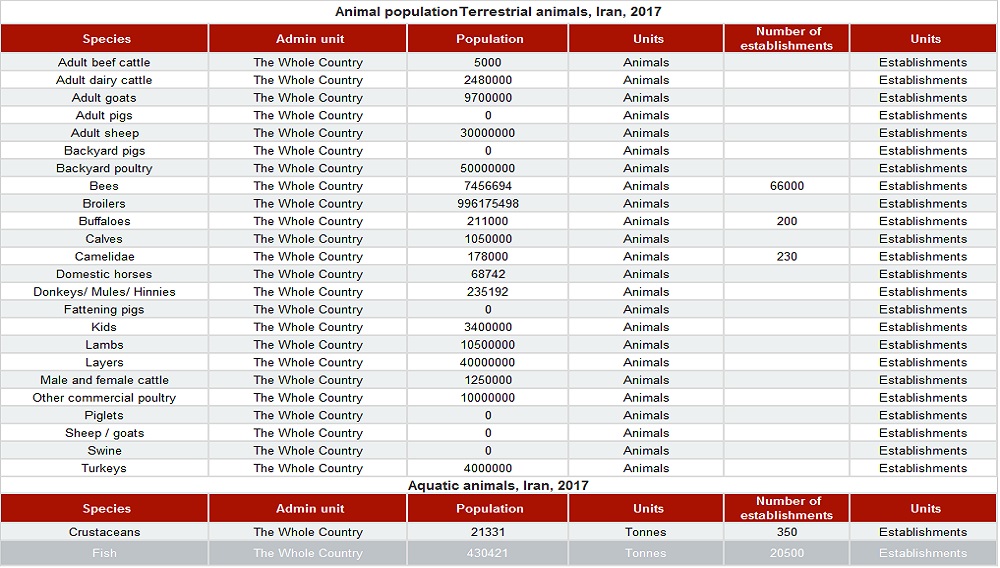Iran and its capital Tehran, is located in the Middle East, between Turkey and Iraq on the west and Afghanistan and Pakistan on the east; it borders the Persian Gulf and the Gulf of Oman in the south and Armenia, Azerbaijan, the Caspian Sea, and Turkmenistan in the north.
The country also shares maritime borders with Kazakhstan and Russia (in the Caspian Sea), Bahrain, Kuwait, Oman, Qatar, Saudi Arabia, and the United Arab Emirates.
With an area of 1,648,195 km², Iran is almost three times the size of France or slightly smaller than Alaska.
Most of the country is situated on the Iranian Plateau (a geological formation in Western and Central Asia), except for the coastal regions at the Caspian Sea and the Khuzestan Province in the southwest at the Persian Gulf. The Zagros Mountains in the west form the largest mountain range in Iran, Iraq, and southeastern Turkey. In Iran’s north towers the Elburz or Alborz mountain range that stretches from the border of Azerbaijan along the western and entire southern coast of the Caspian Sea. Mount Damavand, at 5,610 m (18,410 ft), is Iran’s highest mountain located in the Elburz mountain range.
Iran Population 2020
| 83,977,742 | Current population |
| 42,587,784 | Current male population (50.7%) |
| 41,389,958 | Current female population (49.3%) |
Natural Regions
Iran’s interior plateaus are almost completely surrounded by mountains. The main mountain system, the Zagros Mountains, cuts across the country for more than 1,600 km (1,000 mi) from northwest to southeast. With the exception of the Khūzestān coastal plain, which extends from the northern reaches of the Persian Gulf, the Zagros Mountains occupy all of western Iran.
Peaks rising above 2,300 m (7,500 ft) capture considerable moisture, which percolates down to the lower-lying basins as groundwater. These basins, ranging from about 1,200 to 1,500 m (about 4,000 to 5,000 ft) in elevation, contain fertile soil that traditionally has sustained diverse and intensive crop cultivation.
Agriculture
Iran’s agricultural sector contributed 11 percent of the GDP in 2004 and employed 23 percent (1996) of the labor force.
Since 1979 commercial farming has replaced subsistence farming as the dominant mode of agricultural production.
Wheat, rice, and barley are the country’s major crops. Total wheat and rice production fail to meet domestic food requirements, however, making substantial imports necessary. Other principal crops include potatoes, legumes (beans and lentils), vegetables, fruits, sugar beets, sugarcane, fodder plants (alfalfa and clover), nuts (pistachios, almonds, and walnuts), spices (including cumin, sumac, and saffron), and tea. Honey is collected from beehives, and silk is harvested from silkworm cocoons. Livestock products include lamb, goat meat, beef, poultry, milk, eggs, butter, cheese, wool, and leather. Major agricultural exports include fresh and dried fruits, nuts, animal hides, processed foods, and spices.
Plants and Animals
On the semi-humid plateaux of Iran, grass cover is used for grazing livestock. Approximately 11% of the country is forested. The Zagros Mountains have a semi-humid forest cover dominated by oak, elm, pistachio, and walnut trees. On the seaward slopes of the Elburz Mountains and on the Caspian plain, vegetation is abundant. In these areas’ broadleaf deciduous trees such as ash, elm, oak, and beech flourish, along with some broadleaf evergreens, ferns, and shrubs. On the arid plateaux, scrub and cactus growth dominate.
Iran has a wide variety of indigenous wildlife. Fauna includes the rabbit, fox, wolf, hyena, jackal, leopard, deer, porcupine, ibex, bear, badger, weasel, lion, and the now-rare tiger. Pheasant and partridge are found inland; pelican and flamingo breed along the Persian Gulf. There are sturgeon, whitefish, and herring in the Caspian Sea.
A wide variety of native mammals, reptiles, birds, and insects inhabit Iran. Many species of mammals—including wolves, foxes, bears, mountain goats, red mountain sheep, rabbits, and gerbils—continue to thrive. Others—including Caspian tigers, Caspian seals, desert onagers, three species of deer, gazelles, and lynx—are endangered despite the establishment of special wildlife refuge areas and other government programs initiated to protect them. Some 323 species of birds inhabit Iran; more than 200 species are migratory birds that spend part of the year in other countries.
Livestock
the country’s livestock, sheep are by far the most numerous, followed by goats, cattle, donkeys, horses, water buffalo, and mules. The raising of poultry for eggs and meat is prevalent. One area where production infrastructure has progressed rapidly is the poultry sector. The face of the industry has now been transformed dramatically so that the entire supply chain process can take place domestically.
Iran has also a large dairy industry and imported close to two million tons of feed grain annually in 2006. The raising of pigs is forbidden in Iran due to Islamic law.
Production of livestock increased over the past three years to reach 11.3 million tons in 2008 from 10.6 million tons in 2007, and 9.9 million tons in 2006. Meat processing capacity is at 400,000 tons and 140 production units (2009).[23] In 2008, per capita, meat consumption was 26 kg. Iran produced 950,000 tons of red meat and 1,600,000 tons of chicken in 2010.
Fishing
Access to the Caspian Sea, the Persian Gulf, the Gulf of Oman, and many river basins provide Iran the potential to develop excellent fisheries. The government assumed control of commercial fishing in 1952. One government-owned enterprise, the Northern Sheelat Company, was established in 1952, and a second, the Southern Sheelat Company, was established in 1961. In recent years, illegal and off-season fishing, discharge of industrial and agricultural pollutants, overfishing by other Caspian littoral states, and other unfavorable conditions have endangered Caspian fish resources. Between 1990 and 2004, Iran’s total annual Caspian Sea catch declined from 98,000 tons to 32,533 tons, including 463 tons of sturgeon, which yields high-quality caviar.
Iran has 1,786 kilometers of coastline on the Persian Gulf and the Gulf of Oman. These southern waters are rich in fish and other marine resources. In 2004 the catch off the southern coast totaled 299,000 tons. This represented an average annual increase of 12.6 percent since 1976. The southern catch either is used directly by households and restaurants or processed and preserved by industry. Expansion of the fishery infrastructure would enable the country to harvest an estimated 700,000 tons of fish annually from the southern waters. However, increased pollution from the oil industry and other enterprises pose a serious threat to this area’s fishing industry.
Since the Revolution, increased attention has been focused on producing fish from inland waters. Between 1976 and 2004, the combined take from inland waters by the state and private sectors increased from 1,100 tons to 110,175 tons.
Important fish include sturgeon (yielding its roe for caviar), bream, whitefish, salmon, mullet, carp, catfish, perch, and roach.[citation needed] More than 200 species of fish are found in the Persian Gulf, 150 of which are edible, including shrimps and prawns.
Some 692,000 tons of aquatics will be produced across the country by the end of 2008, of which 236,000 tons would be bred and the rest fished from the sea. Per capita consumption of seafood in Iran will reach 8.5 kg by March 2009 and 10 kg a year later.
Caviar: Iranian caviar export is expected to reach $22 million by March 2009.[41] Iran is the world’s largest producer and exporter of caviar in the world, exporting more than 300 tons annually.
Rivers and Lakes
Nearly all of Iran’s numerous rivers are relatively short, shallow streams unsuitable for navigation. The country’s only navigable river, the Kārūn, flows through the city of Ahvāz in the southwest. Most rivers rise in the mountainous regions and drain into the interior basins. Since ancient times, the region’s inhabitants have used the rivers for irrigation. Dams constructed in the 20th century on the Āb-e Dez, Karkheh, Kārūn, Sefid Rud, and other rivers have expanded the area under irrigation and also have provided a principal source of hydroelectricity.
Climate
Iran has a variable climate. In the northwest, winters are cold with heavy snowfall and subfreezing temperatures. Spring and fall are relatively mild, while summers are dry and hot. In the south, winters are mild and the summers are very hot, having average daily temperatures in July exceeding 38 °C (100.4 °F). On the Khuzestan Plain, the summer heat is accompanied by high humidity.
In general, Iran has a continental climate in which most of the relatively scant annual precipitation falls from October through April. In most of the country, yearly precipitation averages 850 millimeters (33.5 in). The major exceptions are the higher mountain valleys of the Zagros and the Caspian coastal plain, where precipitation averages at least 1,000 millimeters (39.4 in) and usually in the form of snow. In the western part of the Caspian, rainfall exceeds 1,500 millimeters (59.1 in) annually and is distributed relatively evenly throughout the year. This contrasts with some basins of the Central Plateau that receive ten centimeters or less of precipitation. Iran is considered colder than neighboring countries such as Turkey and Armenia, due to its higher elevation.
Iran Delegates
Dr. Alireza Rafiepoor
Secretary-General of the WOAH Regional Commission for Asia, the Far East, and Oceania
Head
Iran Veterinary Organization (IVO)
Ministry of Jihad-e-Agriculture
S.J. Asdaabadi St.
Valiasr Ave.
Postal Code: 1431683765
Tehran
IRAN


